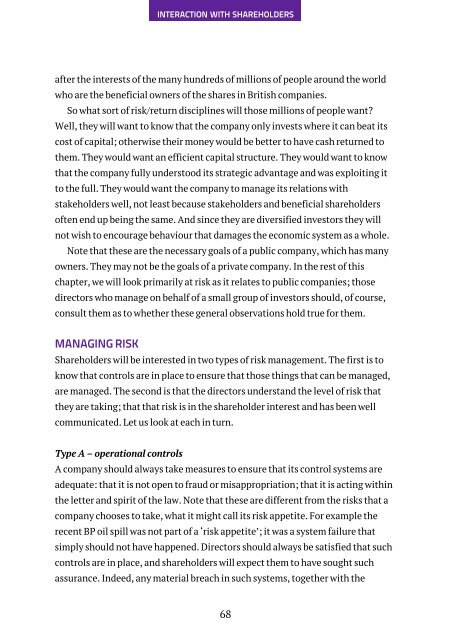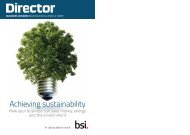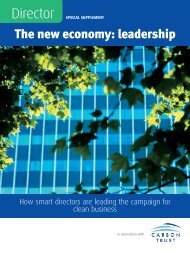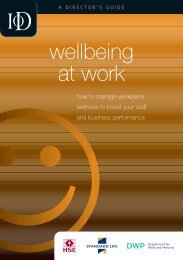Click here to download a pdf - Director Magazine
Click here to download a pdf - Director Magazine
Click here to download a pdf - Director Magazine
You also want an ePaper? Increase the reach of your titles
YUMPU automatically turns print PDFs into web optimized ePapers that Google loves.
INTERACTION WITH SHAREHOLDERSafter the interests of the many hundreds of millions of people around the worldwho are the beneficial owners of the shares in British companies.So what sort of risk/return disciplines will those millions of people want?Well, they will want <strong>to</strong> know that the company only invests w<strong>here</strong> it can beat itscost of capital; otherwise their money would be better <strong>to</strong> have cash returned <strong>to</strong>them. They would want an efficient capital structure. They would want <strong>to</strong> knowthat the company fully unders<strong>to</strong>od its strategic advantage and was exploiting it<strong>to</strong> the full. They would want the company <strong>to</strong> manage its relations withstakeholders well, not least because stakeholders and beneficial shareholdersoften end up being the same. And since they are diversified inves<strong>to</strong>rs they willnot wish <strong>to</strong> encourage behaviour that damages the economic system as a whole.Note that these are the necessary goals of a public company, which has manyowners. They may not be the goals of a private company. In the rest of thischapter, we will look primarily at risk as it relates <strong>to</strong> public companies; thosedirec<strong>to</strong>rs who manage on behalf of a small group of inves<strong>to</strong>rs should, of course,consult them as <strong>to</strong> whether these general observations hold true for them.MANAGING RISKShareholders will be interested in two types of risk management. The first is <strong>to</strong>know that controls are in place <strong>to</strong> ensure that those things that can be managed,are managed. The second is that the direc<strong>to</strong>rs understand the level of risk thatthey are taking; that that risk is in the shareholder interest and has been wellcommunicated. Let us look at each in turn.Type A – operational controlsA company should always take measures <strong>to</strong> ensure that its control systems areadequate: that it is not open <strong>to</strong> fraud or misappropriation; that it is acting withinthe letter and spirit of the law. Note that these are different from the risks that acompany chooses <strong>to</strong> take, what it might call its risk appetite. For example t<strong>here</strong>cent BP oil spill was not part of a ‘risk appetite’; it was a system failure thatsimply should not have happened. Direc<strong>to</strong>rs should always be satisfied that suchcontrols are in place, and shareholders will expect them <strong>to</strong> have sought suchassurance. Indeed, any material breach in such systems, <strong>to</strong>gether with the68









